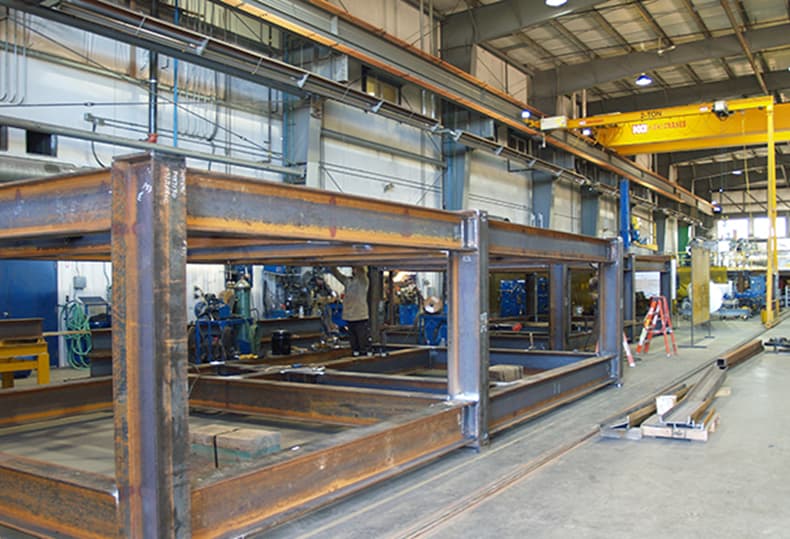Comprehensive Analysis of Cutting-Edge Techniques in Steel Fabrication Market
As the steel fabrication market proceeds to progress, the assimilation of cutting-edge techniques has ended up being necessary for remaining affordable and fulfilling the needs of modern-day production criteria. In this vibrant industry where technology plays a pivotal role, understanding the nuances of these cutting-edge methods is not just a choice but a requirement for those looking to create ahead in the ever-evolving world of steel construction.
Laser Cutting Developments
In the realm of steel fabrication, laser cutting advancements have revolutionized the precision and performance of steel shaping procedures. By taking advantage of the power of focused laser beam of lights, producers can now achieve unparalleled degrees of precision when reducing with various kinds of steels. This innovation allows elaborate designs to be implemented with marginal material wastage, making it a cost-effective remedy for markets needing high accuracy parts.
One of the key benefits of laser cutting is its capability to handle a vast variety of materials, consisting of stainless steel, aluminum, and carbon steel, with convenience. The process generates clean, burr-free edges, removing the requirement for additional ending up steps. Furthermore, the non-contact nature of laser reducing reduces the threat of material contamination, causing higher top quality final result.
Furthermore, laser reducing machines can be configured to make swift, precise cuts, substantially decreasing manufacturing time compared to standard reducing methods. This rate and precision make laser cutting specifically suitable for automation settings where effectiveness is extremely important. As technology proceeds to breakthrough, laser cutting is poised to play a progressively vital role in the steel construction sector.

CNC Machining Innovations
The advancement of CNC machining technologies has ushered in a new age of accuracy and performance in the steel fabrication industry. Computer Numerical Control (CNC) devices have reinvented steel manufacture by supplying unrivaled accuracy and repeatability in the manufacturing process. steel fixing. Among the vital technologies in CNC machining is the assimilation of innovative software program systems that make it possible for real-time monitoring and adjustments, leading to enhanced performance and top quality control
In addition, the growth of multi-axis CNC equipments has actually permitted the construction of complicated steel elements with elaborate designs that were previously testing to generate. These makers can perform a wide variety of machining operations, consisting of milling, boring, turning, and grinding, all with high levels of accuracy.
In addition, the unification of automation and robotics in CNC machining has structured production procedures, lowered preparations, and reduced the margin of error. This assimilation of innovative innovations not only enhances effectiveness but additionally makes certain constant quality throughout all made steel parts. In conclusion, CNC machining technologies continue to drive advancements in the steel manufacture market, establishing new criteria for accuracy and productivity.
Automated Welding Technologies
Automated welding modern technologies have changed the steel construction industry, improving efficiency and accuracy in the welding procedure. These innovative technologies use computer-controlled systems to automate the welding process, causing greater efficiency degrees and improved weld top quality. One of the crucial advantages of automated welding is the capability to perform complicated welds with regular accuracy, minimizing the likelihood of errors and revamp.
Robotic welding systems are at the center of automated welding technologies, using unparalleled speed and accuracy. These systems can handle a wide variety of welding jobs, from image source easy to complex, easily (steel fixing). By making use of advanced sensors and software application, robot welders can adjust to variants in material and joint published here geometry, guaranteeing an attire and trusted weld
Furthermore, automated welding technologies enhance work environment safety and security by decreasing the exposure of human welders to hazardous fumes and intense heat. As the steel construction market remains to progress, integrating automated welding modern technologies will certainly be crucial for companies looking to stay competitive and meet the expanding needs for high-quality welded items.
Robotics Assimilation in Manufacture
Making use of robot systems in manufacture procedures has ended up being a critical technique for enhancing efficiency and precision in modern-day production atmospheres. Robotics combination in steel fabrication offers a myriad of benefits, consisting of boosted efficiency, enhanced quality assurance, and enhanced precaution. These sophisticated robotic systems are equipped with innovative sensing units and programs capabilities, permitting them to do elaborate tasks with a high level of accuracy and repeatability.
One of the vital advantages of robotics assimilation in steel manufacture is the ability to automate repetitive tasks, such as product handling, reducing, welding, and assembly procedures. This not only speeds up manufacturing cycles however additionally minimizes the danger of human mistake, causing higher total product top quality. Furthermore, robots can run 24/7, considerably enhancing production result and meeting limited job target dates.

3D Printing in Steel Manufacturing
Having actually revolutionized the steel fabrication market with robotics integration, the blossoming expedition of 3D printing in steel production is poised to further advancement the world of modern-day production strategies. 3D printing, also known as additive manufacturing, uses unmatched layout liberty and intricacy, enabling the creation of intricate steel structures that were previously unattainable through conventional manufacturing techniques. By utilizing computer-aided style (CAD) software application, makers can specifically regulate the layer-by-layer deposition of steel product, leading to get rid of improved geometries and performances.
One of the essential advantages of 3D printing in steel manufacturing is its ability to reduce product waste dramatically. Unlike subtractive production procedures where excess material is trimmed away, 3D printing only makes use of the essential quantity of steel required for the final component. This performance not just causes cost savings yet additionally lines up with sustainable production techniques by lessening environmental impact.
In addition, 3D printing makes it possible for fast prototyping and customization, enabling the manufacturing of little batches of intricate steel elements with short preparations. As the innovation remains to grow and end up being much more accessible, its assimilation into mainstream steel manufacture processes is expected to drive technology and effectiveness throughout the market.
Verdict
In conclusion, browse around here the steel fabrication industry has seen considerable improvements in methods such as laser cutting, CNC machining, automated welding, robotics assimilation, and 3D printing. These sophisticated modern technologies have actually revolutionized the way steel products are produced, leading to increased precision, cost-effectiveness, and effectiveness. Proceeded financial investment in these cutting-edge strategies is critical for the sector to remain affordable and satisfy the demands of modern production procedures.
As the steel construction market continues to evolve, the assimilation of sophisticated methods has become essential for remaining affordable and meeting the demands of modern-day manufacturing standards.One of the vital benefits of laser cutting is its capability to handle a wide array of materials, including stainless steel, light weight aluminum, and carbon steel, with simplicity.Automated welding technologies have actually transformed the steel fabrication sector, improving performance and accuracy in the welding process.Having actually transformed the steel manufacture market through robotics combination, the growing expedition of 3D printing in steel manufacturing is positioned to further breakthrough the realm of modern-day manufacturing strategies.In conclusion, the steel fabrication market has seen considerable advancements in methods such as laser cutting, CNC machining, automated welding, robotics integration, and 3D printing.